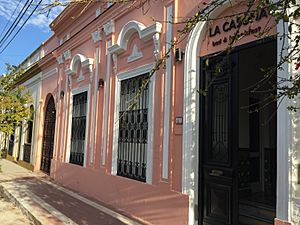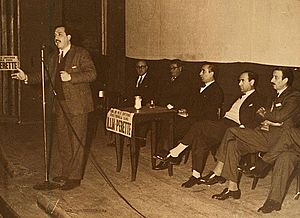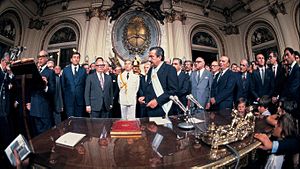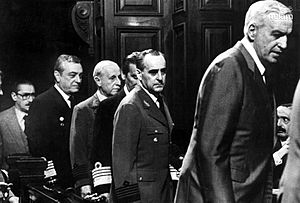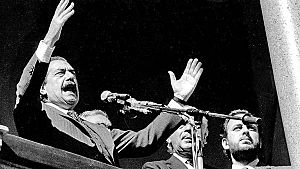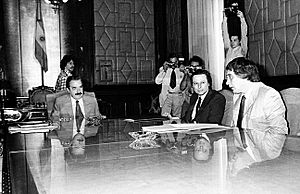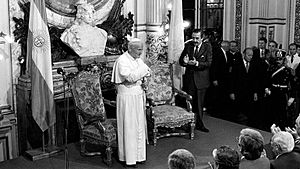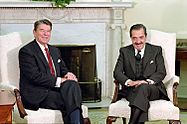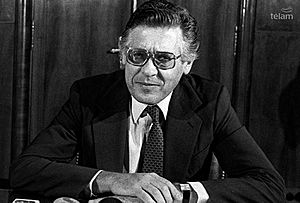Raúl Alfonsín facts for kids
Quick facts for kids
Raúl Alfonsín
|
|
|---|---|
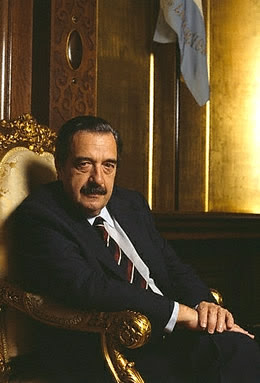
Official presidential portrait (1984)
|
|
| President of Argentina | |
| In office 10 December 1983 – 8 July 1989 |
|
| Vice President | Víctor Martínez |
| Preceded by | Reynaldo Bignone (de facto) |
| Succeeded by | Carlos Menem |
| National Senator | |
| In office 10 December 2001 – 3 July 2002 |
|
| Constituency | Buenos Aires |
| Member of the Constitutional Convention | |
| In office 1 May 1994 – 22 August 1994 |
|
| Constituency | Buenos Aires |
| National Deputy | |
| In office 25 May 1973 – 24 March 1976 |
|
| Constituency | Buenos Aires |
| In office 12 October 1963 – 28 June 1966 |
|
| Constituency | Buenos Aires |
| Provincial Deputy of Buenos Aires | |
| In office 1 May 1958 – 29 March 1962 |
|
| Constituency | 5th electoral section |
| Councillor of Chascomús | |
| In office 7 May 1954 – 21 September 1955 |
|
| Constituency | At-large |
| Personal details | |
| Born |
Raúl Ricardo Alfonsín
12 March 1927 Chascomús, Buenos Aires Province, Argentina |
| Died | 31 March 2009 (aged 82) Buenos Aires, Argentina |
| Resting place | La Recoleta Cemetery Buenos Aires, Argentina |
| Political party | Radical Civic Union |
| Spouse | |
| Children | Ricardo Alfonsín |
| Profession | Lawyer |
| Awards |
|
| Other work(s) | Leader of the Radical Civic Union (1983–1991, 1993–1995, 1999–2001) |
| Signature | |
Raúl Ricardo Alfonsín (12 March 1927 – 31 March 2009) was an Argentine lawyer and politician. He served as President of Argentina from 1983 to 1989. He was the first president chosen by the people after more than seven years of military rule. Many people call him the "father of modern democracy in Argentina."
Alfonsín was a member of the Radical Civic Union (UCR) political party. He believed in social democracy, which means he wanted a fair society with a strong government role. He led the UCR for many years.
Born in Chascomús, Buenos Aires Province, Alfonsín studied law and became a lawyer. He was always against military governments. During a time of great conflict called the "Dirty War," he tried to help people who had disappeared. He also spoke out against the Falklands War. After the military government ended, he became the leader of the UCR and won the 1983 presidential election.
As president, Alfonsín worked to strengthen democracy. He created a group to investigate crimes committed by the military. This led to a famous trial where former military leaders were punished. He also faced challenges from military rebellions and conflicts with powerful labor unions. He helped solve a long-standing border dispute with Chile. His economic plans, like the Austral Plan, tried to fix the economy but faced problems. High inflation and riots led to his party losing the next election.
After his presidency, Alfonsín remained an important political figure. He helped change the Argentine Constitution in 1994. He passed away in 2009 and was given a large state funeral.
Contents
Early Life and Political Start
Raúl Alfonsín was born on March 12, 1927, in Chascomús, a city south of Buenos Aires. His parents were Serafín Raúl Alfonsín Ochoa and Ana María Foulkes. After finishing school, he joined a military high school. He graduated as a second lieutenant but chose not to become a soldier.
Instead, Alfonsín decided to study law. He went to the National University of La Plata and finished his studies at the University of Buenos Aires when he was 23. In 1949, he married María Lorenza Barreneche. They had six children. Only one, Ricardo Alfonsín, also became a politician.
Alfonsín bought a local newspaper called El Imparcial. In 1946, he joined the Radical Civic Union (UCR) political party. He became the head of the party in Chascomús in 1951. In 1954, he was elected to the city council. He was briefly arrested when the government of Juan Perón reacted to a bombing.
Later, a military coup removed Perón from power. Alfonsín was again briefly held and had to leave his city council job. The UCR party split into two groups. Alfonsín chose to follow the group led by Ricardo Balbín.
Alfonsín was elected as a deputy for the Buenos Aires province in 1958. He was reelected in 1962. A military coup in 1962 removed President Arturo Frondizi and closed the provincial legislature. Alfonsín returned to Chascomús. In 1963, he was elected as a national deputy.
Another military coup in 1966 removed President Arturo Umberto Illia. Alfonsín was arrested several times for trying to hold political meetings. He had to resign as a deputy. He also wrote articles in newspapers using different names.
During this time, a period known as the "Dirty War" began. Many groups fought against the military government. Alfonsín made it clear he was against both the military government and the fighting groups. He asked for free elections. He also helped create the Permanent Assembly for Human Rights. He even defended a guerrilla leader in court to make sure he received a fair trial.
Alfonsín was strongly against the 1982 Falklands War. He criticized both sides for sending troops. Argentina's loss in the war weakened the military government. Major political parties then joined together to demand elections. Alfonsín became the leader of the UCR after Ricardo Balbín passed away.
Presidential Campaign and Victory
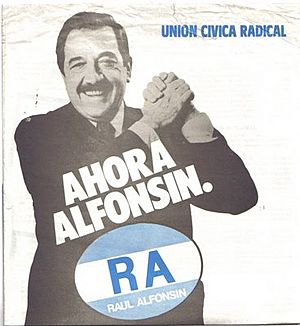
Raúl Alfonsín became the UCR candidate for the 1983 presidential elections. Víctor Martínez was his running mate for vice-president. Alfonsín was very popular. His campaign used the slogan "Ahora Alfonsín" (Now Alfonsín).
During the campaign, Alfonsín promised to reduce the military's power. He also said he would investigate the actions of the military during the "Dirty War." He wanted the armed forces to be under the control of the civilian government. He ended his campaign by reading the beginning of the constitution of Argentina. A huge crowd of 400,000 people attended his last rally.
The elections were held on October 30, 1983. Alfonsín and Martínez won with 51.7% of the votes. This was the first time the Peronist party lost an election fairly since Juan Perón came to power. The UCR won many seats in Congress and elected many governors. Alfonsín became president on December 10, 1983. He gave a speech from the Buenos Aires Cabildo.
Alfonsín's Presidency
One of Alfonsín's main goals was to make Argentina a strong democracy. He wanted the military to return to its normal role. He also wanted to prevent any more military takeovers.
Just three days after becoming president, Alfonsín sent a bill to Congress. This bill removed a law that protected military members from being punished for past crimes. This allowed the courts to investigate human rights violations from the "Dirty War." Alfonsín also ordered trials for both military leaders and guerrilla leaders.
He created the National Commission on the Disappearance of Persons (CONADEP). This group, made up of famous people, collected information about forced disappearances and other human rights abuses. Their report, called "Nunca más" (Never again), showed how widespread these crimes were.
Trial of the Juntas
Alfonsín supported the Trial of the Juntas. This was a very important trial where, for the first time, leaders of a military coup in Argentina were put on trial. The trials began in April 1985. In December, the court sentenced former military leaders like Jorge Videla and Emilio Massera to life in prison. Other leaders received long sentences. This trial was a huge step for justice and democracy in Argentina.
However, some military members were unhappy. This led to a series of rebellions by a group called "Carapintadas" (Painted Faces). They wore military camouflage. In 1987, a major mutiny happened. Many people supported Alfonsín, and large crowds gathered in the Plaza de Mayo. Alfonsín negotiated with the rebels, and they surrendered. To calm the military, the government passed laws that limited further trials for lower-ranking officers.
More mutinies happened in 1988. These were smaller, and the army quickly defeated them. Alfonsín wanted to bring the military and the people back together. But the military was focused on its own issues. In 1989, a small guerrilla group attacked a military base. The army quickly stopped this uprising.
Working with Labor Unions
During his time as president, Alfonsín had disagreements with Argentina's labor unions. These unions were very powerful and were mostly controlled by the opposing Peronist party. Alfonsín wanted to reduce their political power. He feared they could cause problems for the new democracy.
He tried to change the laws for union elections. He wanted to make them more democratic. But the unions saw this as the government interfering. The law was approved by one part of Congress but failed in the other. As a result, the unions remained under Peronist control.
Alfonsín allowed strikes, which had been forbidden during the military rule. There were many strikes during his presidency. However, the unions supported Alfonsín during the military rebellions. They did not want to remove a non-Peronist president. The main reasons for the strikes were high inflation and the unions wanting higher wages.
Social Changes and Policies
After the military government ended, Alfonsín worked to change Argentina's culture and education. He wanted to reduce strict, authoritarian ways of thinking. He also supported freedom of the press. Many smart people and scientists who had left the country during the military rule came back. This helped universities improve.
In 1987, Divorce became legal in Argentina. The church was against it, but many people supported the law. Even some Catholics felt it was a necessary change.
Foreign Relations and Diplomacy
Argentina had a difficult relationship with the United Kingdom after the Falklands War. Alfonsín tried to improve relations. He suggested talking about a peaceful end to the conflict.
A long-standing border problem with Chile, known as the Beagle conflict, was still unresolved. Alfonsín decided to let the people vote on the issue in a referendum. Despite opposition, 82% of the people voted to approve the agreement. The Treaty of Peace and Friendship of 1984 between Chile and Argentina was signed the next year, ending the conflict. In 1987, Pope John Paul II visited Argentina again to celebrate his successful role in helping solve the dispute.
Argentina also worked with Brazil, Uruguay, and Peru. These countries had also recently ended military rule. They formed a group to help solve conflicts between the United States and Nicaragua.
Alfonsín also worked to increase trade with Brazil. In 1988, Argentina, Brazil, and Uruguay agreed to create a common market. This led to the creation of Mercosur in 1991, a major trade bloc in South America. Alfonsín was also the first Argentine leader to visit the Soviet Union officially.
Economic Challenges
Alfonsín faced many economic problems when he became president. Argentina had a huge foreign debt of about 43 billion dollars. The economy was shrinking, and unemployment was high. Inflation was also very high, at almost 209%.
His first economy minister, Bernardo Grinspun, tried to increase wages. But this caused inflation to rise even more. He also struggled to negotiate Argentina's foreign debt.
Then, Juan Vital Sourrouille became the new economy minister. He created the Austral plan. This plan froze prices and wages, stopped printing money, and created a new currency called the Austral. The plan worked well at first and brought down inflation. But inflation started to rise again later. Businesses and unions did not like the price and wage freezes.
The government tried new economic measures in 1987, including higher taxes and selling some state-owned businesses. But these measures were hard to put in place. The government had lost the 1987 elections, and the opposition party did not support them.
A new plan called the "Spring Plan" tried to keep the economy stable until the 1989 elections. But this plan did not work well. International banks refused to lend more money to Argentina. The Argentine currency lost a lot of its value, and high inflation turned into hyperinflation. This economic crisis happened during the 1989 presidential elections. The Peronist candidate, Carlos Menem, won the election.
Midterm Elections
The UCR party did well in the November 1985 elections. They gained more seats in the lower house of Congress. This meant they controlled most of the seats.
However, the government faced a big defeat in the 1987 elections. The UCR lost its majority in Congress. Most provinces elected governors from the Peronist party. This made it difficult for Alfonsín's government to pass new laws. The Peronist party became stronger for the 1989 presidential elections.
Later Years and Legacy

Because of the severe inflation, Alfonsín handed over power to the new president, Carlos Menem, five months earlier than planned, on July 8, 1989.
Alfonsín continued to lead the UCR party for some time. In 1993, he became president of the party again. President Carlos Menem wanted to change the constitution to allow himself to be re-elected. Alfonsín was against this at first. But to avoid more problems, Alfonsín made an agreement with Menem called the Pact of Olivos. With this agreement, the UCR supported Menem's proposal, but with changes that would reduce the president's power. For example, the presidential term was shortened to four years.
Alfonsín was elected to the group that worked on the 1994 amendment of the Argentine Constitution. Even though some in his party disagreed, the UCR supported Alfonsín's agreement. In the 1995 elections, the UCR came in third place, and Menem was re-elected. Alfonsín resigned from leading the party that year.
Later, the UCR joined with another political group to form the Alliance for Work, Justice and Education. This group won the 1997 elections. In 1999, Alfonsín was in a car crash and was hospitalized for over a month.
When President Fernando de la Rúa resigned in 2001 during riots, Alfonsín helped ensure that the Peronist politician Eduardo Duhalde was appointed as the new president by Congress. Alfonsín's health problems later led him to step down from his Senate seat.
In 2008, President Cristina Fernández de Kirchner honored Alfonsín with a statue of him at the Casa Rosada, the presidential palace. This was his last public appearance.
Death and Funeral
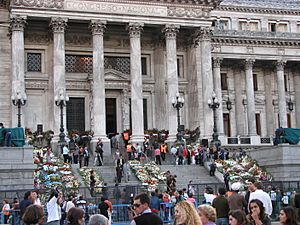
Raúl Alfonsín passed away at his home on March 31, 2009, at the age of 82. He had been diagnosed with lung cancer a year earlier. Hundreds of people gathered outside his house for a candlelight vigil.
The acting president, Julio Cobos, ordered three days of national mourning. A ceremony was held in the Congress building, where his body was displayed. Many important people attended, including former presidents and politicians. His coffin was later moved to La Recoleta Cemetery. He was buried near other important figures from the UCR party.
Many countries, including Peru and Paraguay, declared days of national mourning. Governments from around the world sent messages of sympathy.
Alfonsín's Legacy
Historians praise Raúl Alfonsín's important role in bringing democracy back to Argentina. They also highlight his work after the "Dirty War." Historians agree that Alfonsín was an effective president. He set an example by not using his position for personal gain. They note that it was a very difficult time, and any mistake could have put the new democracy in danger.
Alfonsín received the 1985 Princess of Asturias Awards for his work in solving the Beagle dispute and for bringing democracy back to Argentina. He was also named an "Illustrious Citizen" of Buenos Aires Province in 2008 and of Buenos Aires City in 2009.
See also
 In Spanish: Raúl Alfonsín para niños
In Spanish: Raúl Alfonsín para niños


